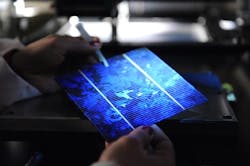Collaboration Picks Up Speed
Collaboration should play an important role in industry, stressed DuPont's senior vice president and chief science and technology officer Uma Chowdhry during a March 23, speech at the American Chemical Society Presidential Symposium in San Francisco, Calif. Today the new global economy makes it the most promising time ever for chemical engineers and chemists to create innovative solutions to issues such as climate change, alternative energy, personal security and a sustainable, safe food supply, Chowdhry explained. To address such mega-challenges, college graduates require much more than scientific and technical depth in a specific area — skills for collaboration and adaptability are essential, too, Chowdhry added.
"Today, more than 8,500 DuPont scientists and engineers in every corner of the world are collaborating with customers and partners in addressing complex challenges that will define the coming decades. From production agriculture and climate change to [alternative] energy and security, our chemists and engineers work in multidisciplinary teams to create novel solutions for the needs of the developing and developed world," he said.
The company's latest collaboration is with Applied Materials, Santa Clara, Calif., a firm that specializes in applying nanomanufacturing technology. They aim to increase the efficiency of crystalline silicon photovoltaic (PV) solar cells to enable PV power to become more cost effective versus other forms of energy.
The key is to reduce the shadowing effect of wide grid lines on solar cells and improve electrical conductivity. Applied Technology's printing techniques coupled with DuPont Solamet PV metallization pastes (Figure 1) should allow narrower and taller grid lines to be precisely printed in two or more layers.
"This collaborative technology will optimize the efficiency of solar cells and meet the needs of the market by ultimately lowering total system cost," says Marc Doyle, global business director DuPont Photovoltaic Solutions, Research Triangle Park, N.C.
Of course, DuPont is hardly alone in such joint efforts. For its part, BASF, Ludwigshafen, Germany, has almost 2,000 collaborations with universities, customers and suppliers worldwide.
One of its most prominent is the BASF Advanced Research Initiative (ARI) at Harvard University, Cambridge, Mass. BASF provides direct funding, up to $20 million over five years. Two topics particularly interest the German company: understanding the formation of biofilms and deriving new strategies to control their growth; and developing new and improved concepts to formulate active ingredients to maximize their bioavailability.
Biofilms have both medical and industrial dimensions. They contribute to infections that afflict numerous patients at hospitals and lead to many deaths. "So there is a need for better understanding of how to control microbes/biofilms, and the need for development of new materials for medical applications," notes Dr. Jens Rieger, research director, polymer research for BASF in Ludwigshafen. Meanwhile, biofouling is a ubiquitous problem in everthing from heat exchangers and water pipes to production equipment and desalination membranes.
"The BASF-Harvard collaboration is combining efforts to answer important questions. In terms of microbiology/medicine, how do chemical, physical and biological stimuli affect biofilm formation and how can we interfere with the cells' circuitry? From a chemical viewpoint, which functional groups and which formulation provide the right stimuli? From the physics side, how are the mechano-chemical properties of the biofilms related to their growth and survival? Finally, there is the question concerning engineering materials science: how can we produce and apply new biofilm-preventing materials? It is the answer to these questions that will lead to breakthrough innovations," says Rieger.
Meanwhile, BP, London, U.K., is focusing its latest collaboration on one of the oldest engineering problems: corrosion. The company has teamed up with the Massachusetts Institute of Technology, Cambridge, Mass., and the University of Manchester, Manchester, U.K, to work on materials and corrosion research. BP's initial investment is about $2 million, with the same funding level available for each of the next four years.
The initial emphasis is on materials and corrosion science — including corrosion and corrosion-fatigue modeling, environmental cracking, novel coatings and new monitoring technology. Efforts will extend over time to other mechanical-integrity and reliability-related areas.
The collaboration aims to provide innovative, interdisciplinary academic input and support for BP's Inherently Reliable Facilities (IRF) program to improve the company's fundamental understanding of engineering materials and corrosion.
"Corrosion control, mitigation, and monitoring are significant concerns in our industry," notes Simon Webster, BP vice president. "We recognized that the future success of the IRF program depends on having reliable long-term access to highly specialized materials and corrosion expertise and laboratory facilities. Our collaboration with MIT and Manchester will provide us with the world-class research access we need."
"The MIT/BP collaboration is an exciting opportunity to develop a fundamental understanding of the underlying mechanisms of environmental degradation and the application of this understanding to the development of advanced materials for use in extreme environments such as those found in the oil and gas industry," adds Ron Ballinger, professor of nuclear science and engineering and materials science and engineering at MIT.
Broader Collaborations
Other joint efforts involving multiple institutions or companies also have recently been launched.
For instance, pharmaceutical giant GlaxoSmithKline (GSK), Brentford, U.K., is part of a new consortium that aims to develop and validate multi-parameter in-line real-time sensors for liquid streams. (See "Initiative Promises Better Sensors")
Another collaboration is the Center for Operator Performance (COP), Dayton, Ohio, which focuses on researching human capabilities and human factors engineering. Formed in 2006, the COP now boasts 10 members, including BP, Chevron, Flint Hills Resources, Marathon, NOVA Chemicals and Suncor Energy, as well as automation vendors ABB and Emerson Process Management. And membership looks to grow. "Some companies who have deferred joining in the past for economic reasons (membership is $25,000 or $50,000, depending on category) are now coming on board. The latest is a major chemical production company, which has said that after talking about joining for a long time, now is the time to step up. This bodes really well for the chemical industry as a whole — and for our organization, too," notes Dave Strobhar of Beville Engineering, who played a leading role in founding the center.
The COP already has completed research projects on a variety of topics such as alarm actuation rate, color usage in process-control graphic displays, effective use of simulators, and decision-making exercises (DMX). (For insights from the first project, see "Build Operator Expertise Faster".)
"The most important benefit for us so far has come from the use of DMX, particularly with our young engineers," says Ike Brackin, process control engineer, Flint Hills Resources, Corpus Christi, Texas. "So we now offer scenario-based training that is developing around activities such as general fractionation and boiler operations. It really helps to enhance troubleshooting skills — for example, to show the operator that what was thought to be a temperature problem is in reality a pressure problem."
Since DMX has been implemented the company has gained a much deeper insight into its how its operators function, notes Brackin. "We now know what areas they need help and training in. For example, we found that one operator didn't understand compressor errors quite as well as he thought. DMX really helps us to focus individual training."
For Emerson Process Management, Austin, Texas, the most important research projects so far relate to alarm actuation rates, display design and display mapping. "These started out with an initial pilot project and are now into their second stage of research. Other projects that are underway, specifically knowledge management and data mining, will tie in nicely with both alarm- and display- related research. We are already incorporating some of the research into our next release, DeltaV v. 11, which will be released in the next few months," says Mark Nixon, who leads DeltaV research efforts.
Emerson's education department is evaluating how best to apply DMX both to classroom and online training situations, Nixon notes.
The COP has three pending projects: human factors performance metrics, naive realism in graphics, and data mining of near-miss incidents. "'Pending' here means that lots of discussions are taking place back and forth between the members about these," explains Strobhar. "Different companies might have quite different focuses — for example, what Marathon wants out of the research might not be exactly what Chevron wants. We are currently going through this discussion phase with the naive realism project."
Naive realism will be a key technology, believes Nixon. The basic idea here is that what users want — displays that visually represent the plant — actually degrades performance. "Although much has been published recommending not using P&IDs [process and instrumentation diagrams], most plants today continue to mimic their plants through the P&ID representations. What has not been published is scientific material supporting alternatives to what has become the standard in most facilities," he says.
Biorefinery Project
Meanwhile, one of the biggest collaborative efforts ever seen in Europe began in March with the launch of the four-year, €23-million European Multilevel Integrated Biorefinery Design for Sustainable Biomass Processing (EuroBioRef) project. This aims to bridge the gap between agriculture and the chemical industry by integrating the whole biomass chain in a multi-feedstock, multi-process, multi-product, commercial, viable and adaptable approach for a sustainable bioeconomy in Europe.
To this end, the project deals with the entire process of transforming biomass, from fields to final commercial products. It also specifically aims to overcome the fragmentation in the biomass industry by facilitating better networking, coordination and cooperation among a wide variety of organizations (Figure 2). The effort involves 28 partners from 14 countries. Mainstream processing is represented by: Arkema France, Paris; Borregaard, Sarpsborg, Norway; Novozymes, Bagsvaerd, Denmark; Haldor Topsoe, Lyngby, Denmark; Merck, Darmstadt, Germany; and Umicore, Hanau, Germany.
As feedstock, the project is targeting sustainable non-food oils, cellulosic and hemi-cellulosic residual materials, lignin and all the associated solid residues. Target products comprise chemicals including monomers and solvents, polymers and aviation fuels, among others.
"This project is really multi-product, with a core of about 30 compounds but with a lot of possible variations and applications that will also be addressed. We really intend to replace the model of a petrorefinery with a new model of biorefinery. This includes, of course, bioproducts that are homologous to petroproducts, but also new products to be delivered to the market, which take full advantage of the specificity of biomass-derived platform molecules," explains project coordinator Franck Dumeignil, a professor at the Université Lille Nord de France, Lille, France.
Dumeignil says the project wants to reach the Holy Grail of full integration: "All the processes will be integrated, including enzymatic catalysis, homogeneous catalysis, heterogeneous catalysis, thermochemical conversion, all with proper, innovative, integrated low-energy separation processes."
Flexibility will be key. The aim is to make process implementation very easy in any part of Europe — taking into account factors such as the amount of locally-available biomass and the target market.
"The project will not just stay at the study stage; rather, the processes that are developed will be commercialized. European citizens will see real, concrete new-generation biorefineries, which will have a strong socioeconomic impact," adds Dumeignil.
Scottish Push
Meanwhile, February saw the launch of two collaborations to bolster industrial/academic relationships in Scotland. The first, ScotCHEM, is a partnership between the country's seven leading universities, the private sector and the Scottish government, with the aim of spurring substantial expansion of world-class chemistry research in Scotland.
"Scotland's new R&D proposition will ensure that any needs of the wider international chemicals community that can be met by the skills and knowledge base existing within Scotland are appropriately met within our infrastructure and academic community," says Chris Gilmore, senior representative of ScotCHEM and a professor in the department of chemistry at the University of Glasgow, Glasgow, U.K.
The second initiative is a new industry-led Centre of Excellence for Continuous Manufacturing and Crystallization that will strive to advance the production of high-value pharmaceuticals and medicines beyond existing boundaries. Discussions are underway about the location and start-up date for the Center, according to a spokeswoman from Chemical Sciences Scotland, Falkirk. A final decision is expected in the summer.
Seán Ottewell is Chemical Processing's Editor at Large. You can e-mail him at [email protected].


